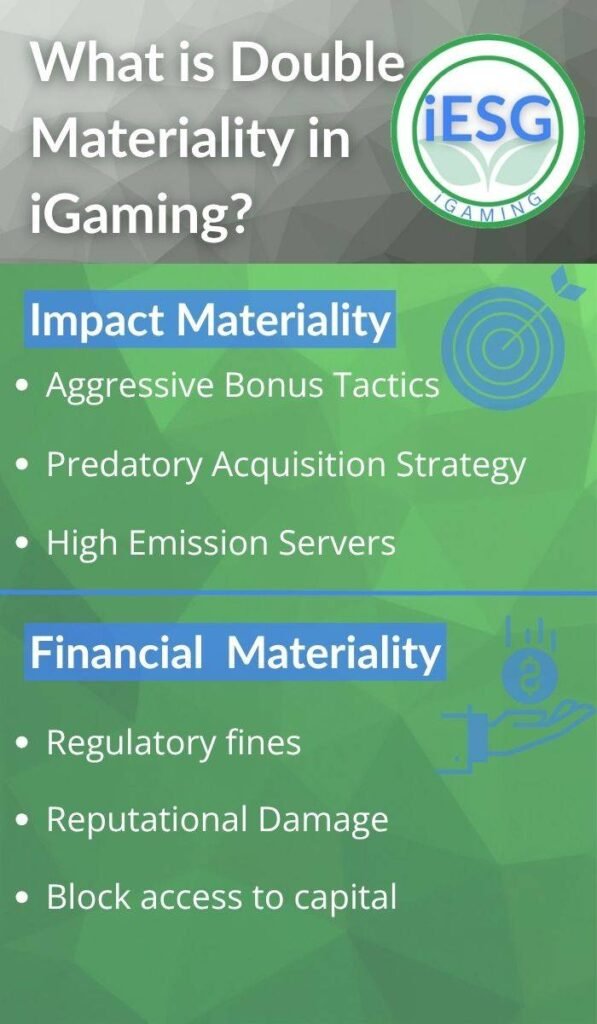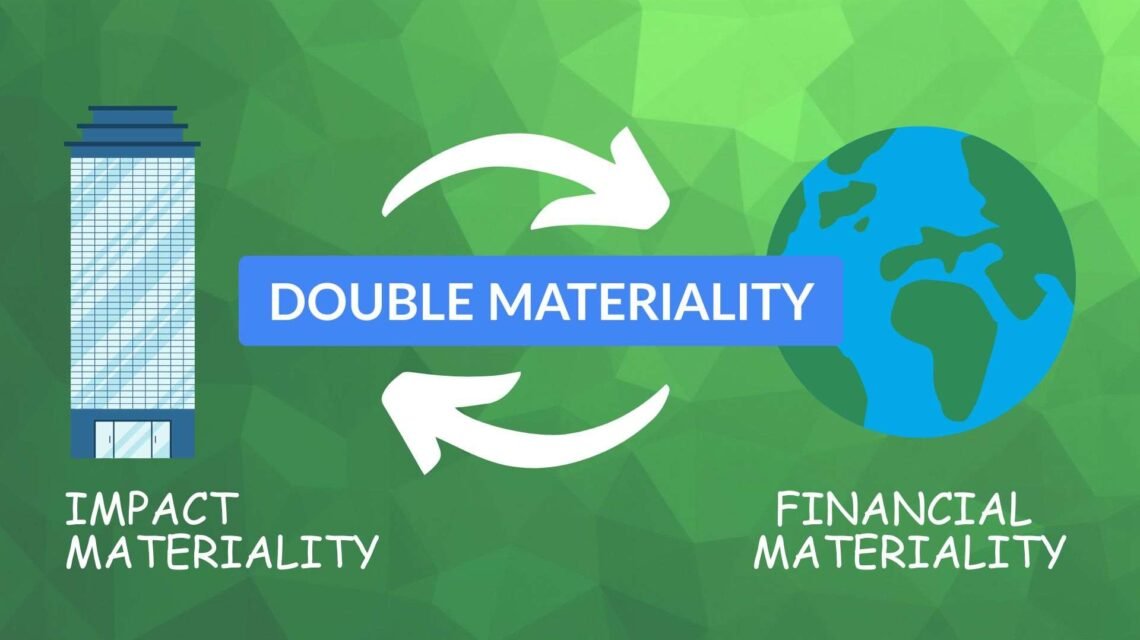The sustainability game is changing—and it’s also affecting the iGaming industry. Just think about the evolution of compliance: what was once seen as optional is now becoming a core expectation from regulators, investors, and players alike. The reality in 2025 is that ESG isn’t just about avoiding fines. It’s about aligning long-term business success with ethical business practices. At the center of this shift is a concept about risk and impact: double materiality in iGaming.
At the center of this shift is a concept about risk and impact: double materiality in iGaming.
This framework is gaining traction in EU legislation, boardroom agendas, and reporting standards. It’s not some soon-gone business trend. It’s here to stay.
If the goal is to build a resilient, trustworthy iGaming brand in 2025 and beyond, understanding double materiality isn’t optional—it’s essential for long-term success.
What Does Double Materiality Mean in iGaming?
Sustainability reporting used to focus solely on what affected a company’s bottom line. That’s no longer enough. Today, businesses must also account for how their operations affect people and the planet.
In simple terms, double materiality means looking at sustainability from two directions:
- Impact Materiality: How does your business affect society, players, and the environment?
- Financial Materiality: How do ESG risks and trends affect your bottom line?
Double materiality in iGaming is, figuratively speaking, comparable to a dual lens—and it’s particularly relevant to this industry. Why? Think about player protection, data ethics, and marketing practices—all are coming under increasing scrutiny.
Why Double Materiality Hits Home in iGaming
The reality is that the iGaming industry faces increasing expectations from regulators, investors, and consumers alike. Add to that the rise of the Corporate Sustainability Reporting Directive (CSRD) and its required double materiality assessments, and the stakes are pretty clear.
To be future-proof, operators should now:
- Map how risky marketing campaigns affect vulnerable players.
- Identify how reputational damage impacts license retention and investor sentiment.
- Report how data protection practices affect trust—and retention rates.
These aren’t just operational details—they’re material risks. And both your external impact and internal exposure must now be documented and disclosed¹.
Real-World Examples: Double Materiality in Practice
Double materiality isn’t theory. It’s a reporting model that maps real-world risks and impacts across businesses. Let’s break it down for the specific iGaming context.
Impact Materiality:
What is the company doing that might affect people or the planet?
Here are some practical examples to better illustrate it:
- Using aggressive bonus tactics that increase risk for vulnerable players, potentially contributing to problematic gambling behavior.
- Partnering with third-party affiliates that use questionable lead-gen tactics or target self-excluded players.
- Running high-emission server infrastructure without carbon mitigation, despite scalable greener alternatives.
All of these practices were common in the wild west days of iGaming. But in 2025? The tide has turned. The industry has adapted—and these actions directly influence public trust, social well-being, and broader environmental goals.
Financial Materiality:
This is particularly relevant for the iGaming industry, where risk minimization is a crucial pillar of a successful business venture. What external factors could harm the business?
Examples include:
- Regulatory fines for safer gambling violations, which can erode profit, trigger license reviews, and lead to negative media coverage.
- Public backlash or negative press for irresponsible advertising or unethical marketing, leading to reputational damage and player exodus.
- Increasing investor pressure on ESG transparency—failure to report on social risks or governance shortcomings could block access to capital or partnerships.
Each of these has serious financial consequences and shows why ESG and risk need to be aligned².
Double Materiality Under the CSRD: What’s Required
Not every iGaming operator is immediately affected—but for those in scope, the Corporate Sustainability Reporting Directive (CSRD) introduces a clear mandate: document how your business both impacts the world and is affected by sustainability risks.
Under the CSRD, covered companies need to show¹:
- Which ESG topics are material from both an impact and financial perspective
- How those topics were identified (e.g., through stakeholder engagement, peer benchmarking, risk mapping)
- What mitigation or action plans are in place—and how progress will be tracked
- Evidence of governance structures tied to these responsibilities
And this isn’t a “maybe later” requirement. For many larger or EU-based operators, CSRD compliance kicks in between 2025 and 2027².
What iGaming Teams Should Be Doing Right Now
No need to panic! The good news is that this shift doesn’t require overnight transformation. However, it does demand strategic planning and alignment.
Here’s what iGaming platforms should prioritize:
- Run a Double Materiality Workshop
Bring together teams from compliance, product, marketing, and finance. Make ESG part of the cross-department strategy—not a silo. - Audit Your RG and ESG Data
Do you track self-exclusion trends post-campaign? Do you log affiliate infractions or carbon output? - Evaluate Affiliate Risks
Many iGaming brands absorb reputation or regulatory hits through third-party channels. Make ethics part of your partner review. - Choose Your Reporting Framework
Global Reporting Initiative (GRI) and European Sustainability Reporting Standards (ESRS) are top contenders. Pick one that suits your operation’s scale and jurisdiction⁴.
- Engage Assurance Partners Early
CSRD mandates limited assurance from 2026—growing into full reasonable assurance by 2030. Don’t wait until audit panic sets in.
How Double Materiality in iGaming Drives Better Business
Think this is just about compliance? Think again. Platforms that adopt a double materiality mindset are not only eliminating risks—they’re seeing advantages across the board:
- Stronger player trust and retention
Transparency and responsibility improve customer loyalty. - Lower risk of regulatory fines and penalties
Clear governance leads to faster responses and fewer violations. - Improved investor relations
ESG clarity is now a serious decision factor for stakeholders and funding bodies.
- Sharper business strategy
Understanding both impact and risk can be a game changer. It helps uncover operational blind spots and leads to better long-term planning.
Verdict: Double Materiality in iGaming Is a Roadmap for Relevance
Double materiality isn’t just a compliance stint or a passing regulation. It’s a way of thinking about business that helps build platforms designed to last.
Whether it’s VIP strategy, retention tactics, affiliate policies, or onboarding flow—aligning social impact with financial goals is now part of being a credible brand. And a successful one.
And in iGaming, credibility is currency.
FAQ – Double Materiality in iGaming
What is double materiality in ESG?
It means reporting both how your company impacts society and how external sustainability risks affect your business.
Why is double materiality in iGaming relevant?
Because the sector influences public trust, player well-being, and data ethics—and it also faces high regulatory and reputational risk.
What is required under CSRD?
You must assess both impact and financial risks, map the value chain, and document your findings in line with EU sustainability standards.
What frameworks help with reporting?
Global Reporting Initiative (GRI) and European Sustainability Reporting Standards (ESRS) are the most relevant. They offer structured guidance to ensure your assessments meet EU expectations.
What are the benefits of double materiality in iGaming?
Double materiality in iGaming strengthens compliance, improves stakeholder trust, and prepares you for future regulatory and market shifts.

Sources:
¹ EFRAG – European Financial Reporting Advisory Group: “Sustainability Reporting.”
https://www.efrag.org/en/sustainability-reporting
² European Commission: “Corporate Sustainability Reporting Directive (CSRD).”
https://ec.europa.eu/info/publications/corporate-sustainability-reporting_en
³ PwC: “Understanding Double Materiality.”
https://www.pwc.com/gx/en/services/sustainability/double-materiality.html
⁴ Global Reporting Initiative (GRI): “GRI Standards.”
https://www.globalreporting.org/standards/

